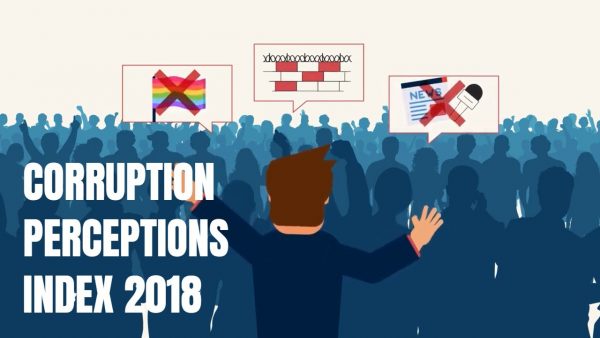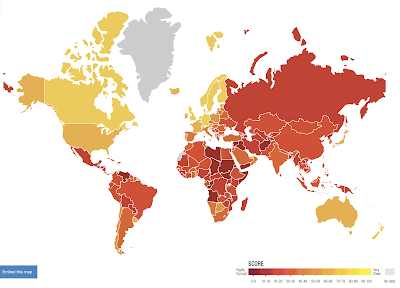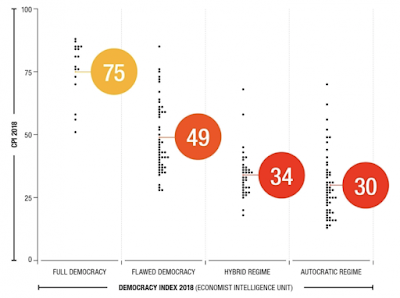
This article was last updated on April 16, 2022
Canada: ![]() Oye! Times readers Get FREE $30 to spend on Amazon, Walmart…
Oye! Times readers Get FREE $30 to spend on Amazon, Walmart…
USA: ![]() Oye! Times readers Get FREE $30 to spend on Amazon, Walmart…
Oye! Times readers Get FREE $30 to spend on Amazon, Walmart…
Transparency International, a non-partisan global movement that has a vision in which government, business, civil society and the daily lives of people are free of corruption, has recently released the most recent version of its annual Corruptions Perceptions Index for 2018. This index ranks 180 nations by the perceived level of public sector corruption according to experts and businesspeople that deal in each nation. Given that high levels of government corruption are often accompanied by a poor quality of life and threatened democracy, this measure is an important aspect of life around the world.
Let’s open by looking at this video which gives you some background on this years Corruption Perceptions Index or CPI:
The 2018 CPI draws on 13 surveys and expert assessments to measure public sector corruption with scores ranging from zero (highly corrupt) to 100 (very clean). In 2018, more than two-thirds of the 180 nations in the study scored below 50 with the average for all 180 nations being 43.
Here is a map showing the scores for all nations in the study:
The top ten nations (least corrupt) and their respective scores are as follows:
Denmark – 88
New Zealand – 87
Finland – 85
Singapore – 85
Sweden – 85
Switzerland – 85
Norway – 84
Netherlands – 82
Canada – 81
Luxembourg – 81
The bottom six nations (most corrupt) and their respective scores are as follows:
Libya – 17
Afghanistan – 16
Equatorial Guinea – 16
Guinea Bissau – 16
Sudan – 16
North Korea – 14
Yemen – 14
South Sudan – 13
Syria – 13
Somalia – 10
As a whole, the highest scoring region is Western Europe and the European Union with an average score of 66. The lowest scoring region is Sub-Saharan Africa with an average score of 32. Over the last seven years, only 20 nations have improved their CPI scores and 16 nations have seen significant decreases in their CPI scores
There is an interesting relationship between CPI scores and the degree of democracy as measure by Freedom House in each of the 180 nations; there are no democracies that score below 50 and very few autocratic countries that score higher than 50 as shown on this graphic with every dot represents a nation’s CPI score:
Government corruption is something that you are highly unlikely to hear about from your elected representative no matter what nation you are from. High levels of corruption slowly chips away at democracy to produce a reality where democratic institutions are completely undermined and citizens experience declining civil rights.
What is rather surprising is how poorly the United States fared in this analysis. The authors of the study scored the United States at 71, putting them in 22nd place, just ahead of the United Arab Emirates and down from 16th place in 2015. The U.S. CPI score in 2018 is a drop of 4 points since 2017 and is the lowest score that the U.S. has garnered over the past 7 years. The authors attribute this drop to leadership styles that involve the following tactics:
1.) an undermining of free and independent media, especially when coverage challenges leaders’ messaging
2.) a silencing and control of civil society and international organisations
3.) an increase in voter suppression and disenfranchisement
4.) an increase in anti-immigrant, anti-LGBT, anti-indigenous and racist language
5.) a rise in public promises for simplistic and “strong hand” approaches to solving deep-rooted and complex societal problems, including corruption
6.) an interference with or blunt use of national institutions to weaken the system of checks and balances and increase executive power
7.) an increase in conflicts of interest and private influence
Let’s look at the scores of some other nations that we see in the media on a regular basis:
Germany – score of 80 – 11th place (tie)
United Kingdom – score of 80 – 11th place (tie)
Japan – score of 73 – 18th place (3 place tie)
Israel – score of 61 – 34th place
Saudi Arabia – score of 49 – 58th place (tie)
Cuba – score of 47 – 61st place (tie)
India – score of 41 – 78th place (five place tie)
China – score of 49 – 87th place
Iran – score of 28 – 138th place (6 place tie)
Russia – score of 28 – 138th place (6 place tie)
Iraq – score of 18 – 168th place (tie)
Venezuela – score of 18 – 168th place (tie)
I find it rather interesting that nations that have been subjected to America’s nation rebuilding and rebranding exercises (i.e. Libya, Iraq and Afghanistan) score among the lowest of all nations in the study, indicating that very little has been accomplished when military intervention is measured in terms of reduced government corruption.
As we can see from this analysis by Transparency International, government corruption is a widespread problem outside of Europe and Canada. With the close relationship between high levels of government corruption and lack of democratic freedoms, many of us, particularly in the United States, should be concerned that our basic rights as members of what was once a relatively untarnished society are under threat. We need look no further than the Supreme Court’s 2010 Citizens United v. Federal Election Committee to see the source of at least one aspect of political corruption in the United States.
Click HERE to read more from this author.
You can publish this article on your website as long as you provide a link back to this page.



Be the first to comment